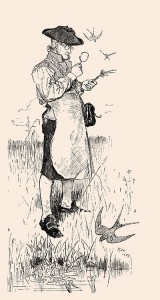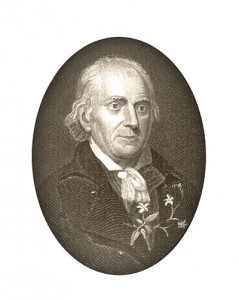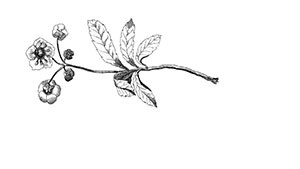Some four miles south of Philadelphia, across the Schuylkill River from a squat row of oil refinery tanks, stands a terraced garden. The slope, dotted with shrubs, flowers, and towering trees, leads to an impressive house that glitters when sunlight strikes certain pieces of the stone it’s made of. Carved into the front of the house and dated 1770 are the words, “It is God Alone, Almyty, Lord/The Holy One by Me Ador’d.”

Couplet, carving, house, adjacent greenhouse, and garden—all are the handiwork of forgotten founding father John Bartram.
No portrait exists of Bartram; he was a Quaker, and Quakers eschewed portraiture as vanity. Son William, though, drew his father at work as the de facto founder of the field of botany in colonial America.
Born in 1699 to a comfortable farming family, Bartram was in his 20s and idly examining a daisy in a field when his calling came. “What a shame, said my mind, or something that inspired my mind, that thee shouldst have employed so many years in tilling the earth, and destroying so many flowers and plants, without being acquainted with their structures and their uses,” he later recalled. Soon, he was teaching himself Latin to understand the work of Swedish botanist Carl Linnaeus and “botanize his fields.”
Over four decades, Bartram roamed from New England to Florida, from coastal plains to the Ohio Valley—collecting, tending, and documenting botanical specimens. His pastime became a business selling the seeds of North American trees and shrubs to European aristocrats hungry for New World novelty. It is hard to imagine how exotic New World flora were 300 years ago.
Bartram made his first known collecting trips in the 1730s. Through fellow Quaker Joseph Breintnall he began corresponding with London-based Peter Collinson, a Quaker clothing merchant who shared Bartram’s plant mania. Bartram began sending Collinson boxes of specimens and plants; Collinson repaid in kind with plants from Europe and Britain’s empire. He would chide Bartram for not sending popular items: “I am really concerned there are no Acorns.” In nearly 40 years of corresponding the men never met, but Collinson, a member of the Royal Society, conveyed Bartram’s observations to Linnaeus and other scholars.

Sometimes aristocratic customers—who paid a subscription to fund Bartram’s expeditions—had to wait years for a plant to bloom. Not knowing what it would look like was part of the thrill, according to Bartram’s Garden curator Joel Fry. The earliest boxes, from 1735, contained thousands of seeds of 100-odd shrubs such as laurel, magnolia, and rhododendron, as well as trees like hickory, tulip, red cedar, and sassafras. Later boxes included seeds for persimmon, pawpaw, dogwood, black mulberry and serviceberry, evergreens, and oaks.
On his expeditions Bartram drew on Quaker connections, but the work was not easy or safe. “I want much to come to Carolina to observe ye curioisites toward ye mountains but ye mischievous Indians is so treacherous that it is not safe trusting them,” he wrote to Dr. Alexander Garden of Charleston, South Carolina. “No traveling now.” William Bartram often joined his father, later becoming an explorer and naturalist in his own right, describing birds and other animals as carefully as his father did plants.
By 1765 Bartram had been named “the King’s Botanist,” with an annual pension until his death in 1777, just four days before the British invaded Philadelphia. His home went unharmed and Bartram’s sons, and later his granddaughter and husband, continued the plant business until the crash of the 1830s. By then, North American plants no longer commanded a premium in England. Three generations of Bartrams had introduced more than 2,000 species from North America to Europe; American ginseng became a valuable trade item in China.

In 1850, rail tycoon Andrew Eastwick bought the Bartram property, hiring
gardener Thomas Meehan to tend the property. In 1891, at Meehan’s urging, the city made the estate a park, now managed in partnership with Bartram descendants and home to a community garden, a wetlands, meadows, and access to the Schuylkill for kayakers. Since 1980, the John Bartram Association, a nonprofit, has been revitalizing the property and restoring its historic gardens.
The estate has endured, as Bartram did. When his Society of Friends brethren disowned him in 1758—perhaps suspecting Unitarian sympathies—Bartram kept his faith. Late in life, the now accomplished botanist noted that since age 10 he had “a great inclination to plants and knowed all that I once observed by sight tho not their proper names having no person or books to instruct me.” ✯
This story was originally published in the September/October 2016 issue of American History magazine. Subscribe here.





